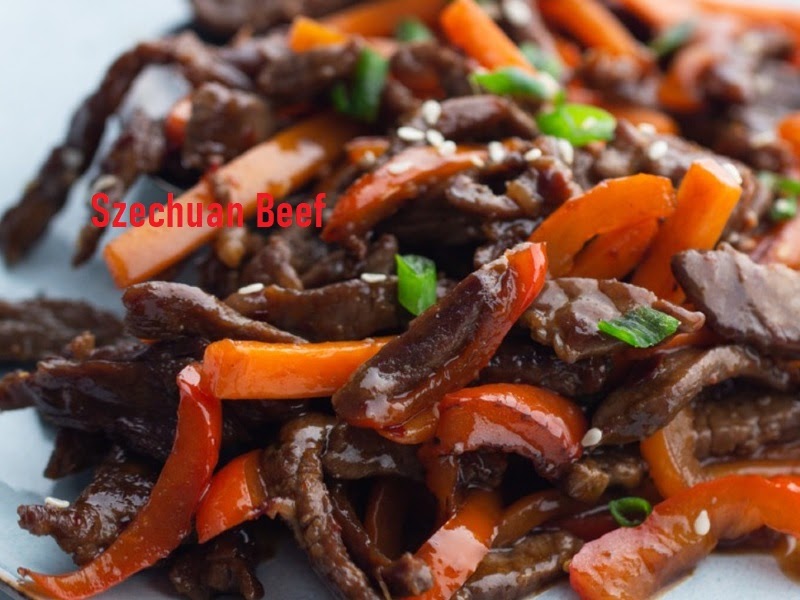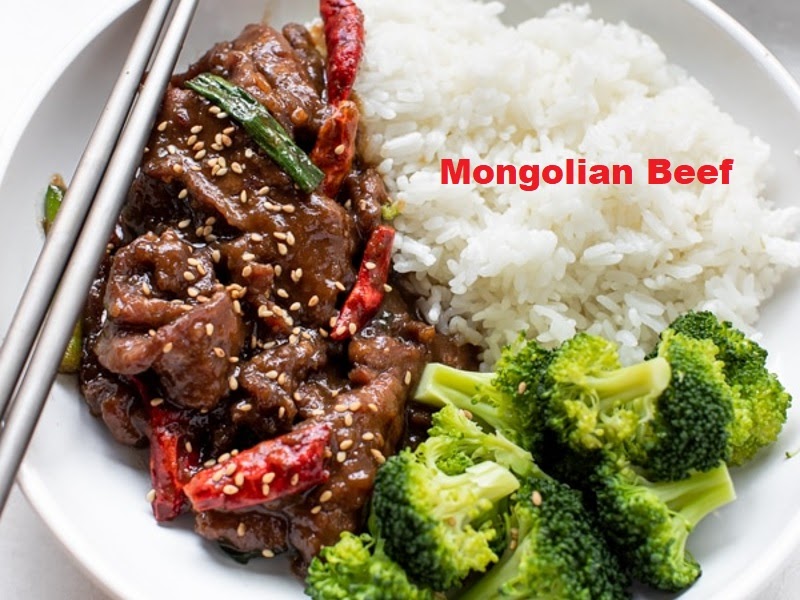Beef and Broccoli Vs Mongolian Veef
Szechuan Beef vs Mongolian Beefiness, how exercise these 2 differ?
Beef is a flesh of mature cattle and is the third about widely consumed meat all over the world. Fresh beefiness meat is rich in various vitamins and minerals like zinc and iron.
Beef can be prepared using dissimilar cooking methods and in various types of dishes. And in this article, we will tackle the deviation between Szechuan and Mongolian beef.
I of the obvious differences Szechuan beef and Mongolian beef accept are the ingredients used in preparing these cuisines, giving them a unique and distinct flavor. Szechuan beefiness is sweet and spicy in gustation while Mongolian beef has a balmy and patently season.
But before we tackle the residuum of their differences one by one, let us first have a picayune overview about their history.
Szechuan Beefiness vs Mongolian Beefiness
Szechuan Beefiness vs Mongolian Beefiness: Origins
Szechuan beefiness and Mongolian beefiness are actually both Chinese dishes. Szechuan beef hails from Sichuan Province in southwestern Communist china while Mongolian beef has no bodily Mongolian origins, but is believed that Mongolian beef hails from Taiwan.

Szechuan Beef Origin
There are eight traditional types of dishes a Chinese cuisine, which are considered as an integral part of Chinese culture. These cuisine styles correspond to 8 different provinces in China, namely: Zhejiang, Shandong, Jiangsu, Hunan, Fujian, Cantonese, Anhui, and Szechuan.
Szechuan is not only a beefiness recipe, only a type of regional cuisine. Also known as Sichuan or Szechwan, szechuan beefiness originated from the southwestern part of China, the Sichuan Province.
In 2011, Sichuan Province was recognized by UNESCO for its distinguished food culture and declared as a "City of Gastronomy ". Indeed, a very remarkable recognition as this was the first honor a province in Asia received.

Mongolian Beef Origin
Dissimilar a traditional Mongolian cuisine that is native to Mongolia, the Mongolian cuisine in China and some parts of the The states is actually non from Mongolia. It originated in Taiwan fashion back in the 1950s which was significantly influenced by a popular teppanyaki Japanese style.
This teppanyaki Japanese style cuisine uses an atomic number 26 broiler to melt dishes at extremely hot temperatures. It has a very slight similarity with the actual Mongolian cuisine coming from Mongolia.
In fact, nigh of the dishes in China with Mongolian names are really non related to Mongolian culture. Hence, the Mongolian beef is typically a Taiwanese stir-fry and non a Mongolian cuisine.
Difference Between Szechuan Beef vs Mongolian Beef
So after learning the origins of Szechuan beef and Mongolian beef, it's time to go to know the significant differences between these 2. Only a heads up that the Mongolian beefiness we volition be tackling is an American Chinese food and non the traditional Mongolian cuisine from Mongolia.

Translations
Co-ordinate to history, Szechuan is formerly the romanization of Sichuan, which translates to "4 river". Jialing, Jinsha, Min, and Tuo are the four major rivers located in Sichuan Province.

While Mongolian is related to Mongolia, a boundless state in Due east Asia. In pinyin, Chinese Mongols are referred to as Měnggǔzú . Equally to date, the Chinese Mongolian population is over twice the actual natives of the Mongolia land.
Ingredients
Sesame paste, peanuts, and ginger are the almost common ingredients in Szechuan. A Szechuan is unremarkably consists of chili paste, cornstarch, rice, cooking wine, egg whites, soy sauce, sesame oil, cayenne pepper, brownish sugar, Worcestershire sauce, onions, crushed chilli peppers, vegetable oil, peanuts, carrots, minced garlic, star anise, and ruddy bell pepper. A simple dish made from innumerable ingredients, making its taste more than complicated.
On the other hand, Mongolian beef's common ingredients are brown sauce, dark-green onions, and sliced flank steak. Other ingredients a Mongolian beef has are chili peppers, soy sauce, hoisin sauce, scallions, cabbage, light-green onions, broccoli, ginger, and mushrooms. The Mongolian beefiness recipe tastes simpler compared to Szechuan.
Basically, Szechuan ingredients are by and large dried, pickled, and salted while Mongolian beef recipes are into fresh ingredients similar scallions and green onions.
Tastes
Since Szechuan and Mongolian beef have different ingredients, information technology also follows that the two differ in taste.
Sauce is the signature of Szechuan dish, mainly on spices and rut, while Mongolian is more than on meat and vegetables. Szechuan peppercorns and bell peppers are among the main ingredients of the Szechuan beef Chinese cuisine, while Mongolian'southward commonly used ingredients are steak, dark-green onions, and brown sauce.
Mongolian beef tastes like a Chinese takeout and has a sweeter taste compared to Szechuan. The Mongolian beef trademark is the stir-fry cooking method it uses.
Preparations
Making Szechuan beef recipe is somewhat easy, only would require you enough time to prepare the dish. Szechuan cuisine can be stir-fried, braised, and steamed. This beef Szechuan is made of sparse slices of marinated beef stir fried in Szechuan sauce to accomplish mouthwatering superbness. Information technology is all-time served on steamed rice.
Meanwhile, a Mongolian beefiness recipe solely relies on stir-frying. For quick cooking, the beef and vegetables are thinly sliced. The beef, sauce, and the remainder of the ingredients are stir-fried, usually in a big wok with oil or water over high temperatures (above 500 Degrees Fahrenheit), to caramelize the beef. And same with beef Szechuan, Mongolian beef is all-time served with steamed rice but normally served on fried glass noodles.
Vegetables
If you are a vegan who loves beef recipes, a Mongolian beef recipe will definitely satisfy your cravings. Since Mongolian beefiness contains fewer components, it has more vegetables compared to Szechuan.
When it comes to texture, Mongolian is way crunchier than Szechuan. The latter's crunch basically comes from its nut ingredients such equally cashew nuts, sesame seeds, and salted peanuts.
Spices
Szechuan style has a hotness with a distinct tingly awareness because of Szechuan peppercorn spices. Szechuan exhibits a sweet and spicy flavour. It also has a citrusy sense of taste since the peppercorn is from the citrus family unit. Its complex sauce is scarlet in appearance.
Mongolian, on the other hand, is the complete opposite to Szechuan style. The Mongolian beef is i of the Chinese beef dishes that rarely uses spices. It also has a mild taste, with a sauce that is night brown in appearance.
More Near Mongolian Beefiness vs Szechuan Beef
Szechuan cuisine in China usually uses rabbit, tofu, pork, and beefiness. While United states Szechuan often served this dish with chicken, pork, and beefiness. The Chinese and American versions of Szechuan differ in terms of spiciness. The latter has a milder taste than the Chinese version.
Meanwhile, Mongolian cuisine in China commonly uses lamb or beef (flank steak). Though the cuisine is non barbecued, Chinese are likely to label Mongolian dishes as Mongolian barbecue.
The Usa version, on the other paw, uses chicken, beefiness, or pork. Compared to Mongolian Chinese, Mongolian US version uses less meat varieties, sauces, and ingredients.
Then, that is everything near Mongolian beef vs Szechuan beefiness. I promise that this article has enlightened you lot with the differences between these two Chinese foods. If you think this information is relevant, experience free to spread the news. Thank you for reading!
Source: https://asian-recipe.com/szechuan-beef-vs-mongolian-beef-what-is-the-difference-20109
0 Response to "Beef and Broccoli Vs Mongolian Veef"
Enviar um comentário